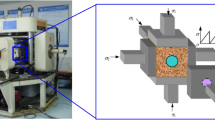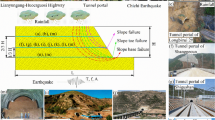Abstract
Buried pipe networks are important components of lifeline systems. An experiment is conducted to test a buried pipe network subjected to an artificial earthquake produced by multi-millisecond blasting. The motivation of the research is to verify the feasibility of using multi-millisecond blasting to simulate earthquakes and to validate the deformation relationship between pipe and soil obtained in a single-point explosion test. Multiple explosives are used with a time-delay technique to create an extended period of loading on pipes. The dimension of the buried pipe network is 24 m × 24 m. The artificial earthquake is produced by trinitrotoluene (TNT) charges. The pipe network consists of ductile cast iron (DCI) pipes, which represent a water distribution network, and welded steel (WS) pipes, which represent a gas supply network. Eighty-five kilograms of TNT charges, which are divided into three parts, are detonated by millisecond blasting. The ground motion of the test field, including the accelerations and velocities at different points, and the pipe dynamic responses, including the joint deformations of DCI pipes and the axial strains of WS pipes, are described in detail. Finally, the deformation law of buried pipe networks and the deformation relationship between pipe and soil are discussed.
Similar content being viewed by others
References
Ashford SA and Juirnarongrit T (2006), Performance of Lifelines Subjected to Lateral Spreading: Japan Blast Test Results, Department of Structural Engineering, University of California, San Diego.
ASTM International (2014), Standard Specification for Seamless Carbon Steel Pipe for High-Temperature Service, West Conshohocken.
Calvetti F, Prisco C and Nova R (2004), “Experimental and Numerical Analysis of Soil-Pipe Interaction,” Journal of Geotechnical and Geoenvironmental Engineering, 130: 1292–1299.
Global Times (2016), “Emergency Rescue Troops: Instant Noodle with Muddy Water,” http://money.163.com/api/14/0806/09/A2V356KH00254U80.html. (accessed 30 March 2016)
Ha D, Abdoun TH, O’Rourke MJ, Symans MD, O’Rourke TD, Palmer MC and Stewart HE (2008), “Centrifuge Modeling of Earthquake Effects on Buried High-Density Polyethylene (HDPE) Pipelines Crossing Fault Zones,” Journal of Geotechnical and Geoenvironmental Engineering, 134(10): 1501–1515.
Hindy A and Novak M (1979), “Earthquake Response of Underground Pipelines,” Earthquake Engineering and Structural Dynamics, 7: 451–476.
Huang B, Liu J, Lin P and Ling D (2014), “Uplifting Behavior of Shallow Buried Pipe in Liquefiable Soil by Dynamic Centrifuge Test,” Scientific World Journal, 2014: 1–15.
Isenberg J, Richardson E and O’Rourke TD (1989), Experiment on Performance of Buried Pipelines across San Andreas Fault, NCEER, State University of New York at Buffalo, New York.
Ivanov R and Takada S (2003), “Numerical Simulation of the Behavior of Buried Jointed Pipelines Under Extremely Large Fault Displacements,” Advancing Mitigation Technologies and Disaster Response for Lifeline Systems, TCLEE, ASCE, Reston, 717–726.
Katayama T (1991), “Use of Dense Array Data in the Determination of Engineering Properties of Strong Motions,” Structural Safety, 10(1–3): 27–51.
Kolbadi S, Mohammad S, Hassani N, Kolbadi S, Mahdi S and Shiravand MR (2015), “Effect of Ground Motions on Nonlinear Seismic Behavior of Corroded Buried Gas Pipeline,” American Journal of Civil Engineering, 3(2–1): 9–13.
Kouretzis GP, Bouckovalas GD and Gantes CJ (2006), “3-D Shell Analysis of Cylindrical Underground Structures Under Seismic Shear (S) Wave Action,” Soil Dynamics and Earthquake Engineering, 26: 909–921.
Kuwata Y, Takada S and Ivanov R (2006), “DEM Response Analysis of Buried Pipelines Crossing Fault and Proposal for a Simplified Method to Estimate Allowable Fault Displacements,” Journal of Systems Engineering and Electronics, 8(4): 195–202.
Ling H, Mohri Y, Kawabata T, Liu H, Burke C and Sun L (2003), “Centrifugal Modeling of Seismic Behavior of Large-Diameter Pipe in Liquefiable Soil,” Journal of Geotechnical and Geoenvironmental Engineering, 129(12): 1092–1101.
Manolis G, Tetepoulidis P, Talaslidis D and Apostolidis G (1995), “Seismic Analysis of Buried Pipeline in a 3D Soil Continuum,” Engineering Analysis with Boundary Elements, 15(4): 371–394.
Maragakis E, Iddharthan RS and Meis R (1999), “Axial Behavior Characteristics of Pipe Joints Under Static Loading,” Research Progress and Accomplishments, 1997–1999, MCEER, University at Buffalo, State University of New York, pp. 55–60.
Meng H, Chen J, Shi X and Li J (2007). “Shaking Table Test of Soil-Pipe Dynamic Interaction Under Non-Uniform Earthquake Wave Excitation,” Proceedings of the Fifth China-Japan-US Trilateral Symposium on Lifeline Earthquake Engineering, Haikou, China, pp. 335–363.
Miao H, Liu W, Wang C and Li J (2016a), “Artificial Earthquake Test of Gas Supply Networks,” Soil Dynamics and Earthquake Engineering, 90: 510–520.
Miao H, Liu W, Wang C and Li J (2016b), “The Seismic Response Test of a Buried Pipe Network Subjected to Artificial Earthquake Produced by Multi-Millisecond Blasting,” Proceedings of the Seventh China-Japan-US Trilateral Symposium on Lifeline Earthquake Engineering, ASCE, Shanghai, 352–358.
Mohri Y, Kawabata T and Ling H (1998), “Experiments on Shallowly Buried Pipelines Using Shaking Table,” Proceedings of the Tenth Earthquake Engineering Symposium, Tokyo, Japan, 1913–1916.
Moradi M, Rojhan M, Galandarzadeh A and Takada S (2013), “Centrifuge Modeling of Buried Continuous Pipelines Subjected to Normal Faulting,” Earthquake Engineering and Engineering Vibration, 12(1): 155–164.
Nasu N, Kazama S, Morioka T and Tamura T (1973), “Vibration Test of the Underground Pipe with a Comparatively Large Cross-Section,” Proceedings of the Fifth World Conference on Earthquake Engineering, ASCE, Rome, Italy, 583–592.
Narang S (2017), “One Year After the Nepal Earthquake, Clean Water Is Still in Short Supply”. http://www.undispatch.com/one-year-after-the-nepal-earthquake-clean-water-is-still-in-short-supply. (accessed 2 March 2017)
Newmark NM (1967), “Problems in Wave Propagation in Soil and Rock,” International Symposium on Wave Propagation and Dynamic Properties of Earth Materials, Albuquerque, New Mexico, United States, 7–26.
O’Rourke M, Gadicherla V and Abdoun T (2003), “Centrifuge Modeling of Buried Pipelines,” Advancing Mitigation Technologies and Disaster Response for Lifeline Systems: Proceedings of the Sixth U.S. Conference on Lifeline Earthquake, ASCE, Long Beach, California.
Prior JC (1935), Investigation of Bell and Spigot Joints in Cast Iron Water Pipes, College of Engineering, Ohio State University, Columbus, Ohio.
Qiao L, Yuan C, Miyajima M and Zhai E (2008), “Shake-Table Testing and FLAC Modeling of Liquefaction-Induced Slope Failure and Damage to Buried Pipelines,” Proceedings of the Fourth Geotechnical Earthquake Engineering and Soil Dynamics Congress, ASCE, Sacramento, California, 1–10.
Rahman MA and Taniyama H (2015), “Analysis of a Buried Pipeline Subjected to Fault Displacement: a DEM and FEM Study,” Soil Dynamics and Earthquake Engineering, 71: 49–62.
Sahoo S, Manna B and Sharma K (2014), “Seismic Behaviour of Buried Pipelines: 3D Finite Element Approach,” Journal of Earthquakes. 2014: 1–9.
Saiyar MS, Take WA and Moore ID (2015), “Post-Failure Fracture Angle of Brittle Pipes Subjected to Differential Ground Movements,” Tunnelling and Underground Space Technology, 49: 114–120.
Sakurai A and Takahashi T (1969), “Dynamic Stresses of Underground Pipelines During Earthquakes,” Proceedings of the Fourth Wolrd Confrenece on Earthquake Engineering, ASCE, Santiago de Chile, 81–95.
Shi P (2015), “Seismic Wave Propagation Effects on Buried Segmented Pipelines,” Soil Dynamics and Earthquake Engineering, 72: 89–98.
Shinozuka M and Koike T (1979), “Estimation of Structural Strains in Underground Lifeline Pipes,”
Proceedings of the Third National Congress on Pressure Vessels and Piping, San Francisco, California, United States, 31–48.
Sim WW, Towhata I, Yamada S and Moinet GJM (2012), “Shaking Table Tests Modelling Small Diameter Pipes Crossing a Vertical Fault,” Soil Dynamics and Earthquake Engineering, 35: 59–71.
Singhal AC (1984), “Behavior of Jointed Ductile Iron Pipelines,” Journal of Transportation Engineering, 110(2): 235–250.
St John CM and Zahrah TF (1987), “Aseismic Design of Underground Structures,” Tunnelling and Underground Space Technology, 2(2): 165–197.
Takada S and Hassani N (2015), Lifeline Earthquake Engineering: Lessons from 1995 Kobe and 2011 East Japan Earthquakes, Kobe, Japan.
Towhata I, Vargas-Monge W, Orense R and Yao M (1999), “Shaking Table Tests on Subgrade Reaction of Pipe Embedded in Sandy Liquefied Subsoil,” Soil Dynamics and Earthquake Engineering, 18(5): 347–361.
Uckan E, Akbas B, Shen J, Rou W, Paolacci F and O’Rourke M (2015), “A Simplified Analysis Model for Determining the Seismic Response of Buried Steel Pipes at Strike-Slip Fault Crossings,” Soil Dynamics and Earthquake Engineering, 75: 55–65.
Wang C, Liu W and Li J (2015), “Artificial Earthquake Test of Buried Water Distribution Network,” Soil Dynamics and Earthquake Engineering, 79: 171–185.
Wang LRL (1986), “Design Considerations for Buried Pipelines Under Various Seismic Environments,” International Journal of Pipelines, 5(3): 65–70.
Wang LRL (1994), “Numerical Seismic Analysis and Modeling of Buried Pipelines,” Soil Structure Interaction: Numerical Analysis and Modelling, New York, 557–603.
Wang LRL and Cheng KM (1979), “Seismic Response Behavior of Buried Pipelines,” Journal of Pressure Vessel Technology, 101(1): 21–30.
Wang YD and Wang Y (2015), “The Emergency Operation of Barrier Lake in Niulan River Hongshi Rock,” China Water Resources, 2: 27–28. (in Chinese)
Yoshizaki K, O’Rourke TD and Hamada M (2003), “Large Scale Experiments of Buried Steel Pipelines with Elbows Subjected to Permanent Ground Deformation,” Structural Engineering and Earthquake Engineering, 20(1): 1–11.
Zhang X, Bai XH and He WB (2013), “The Experiment of Deformation and Internal Force of Soft Pipeline Caused by Subsoil Settlement,” Applied Mechanics and Materials, 275-277: 1493–1498.
Acknowledgement
The support from the Natural Science Foundation of China (Grant No. 51278380) and the Ministry of Science and Technology of China (Grant No. SLDRCE14-B-18) are greatly appreciated.
Author information
Authors and Affiliations
Corresponding author
Additional information
Supported by: Natural Science Foundation of China under Grant No. 51278380 and Ministry of Science and Technology of China under Grant No. SLDRCE14-B-18
Rights and permissions
About this article
Cite this article
Wei, L., Huiquan, M., Chuang, W. et al. Test on a buried pipe network subjected to an artificial earthquake produced by multi-millisecond blasting. Earthq. Eng. Eng. Vib. 19, 791–810 (2020). https://doi.org/10.1007/s11803-020-0596-4
Received:
Accepted:
Published:
Issue Date:
DOI: https://doi.org/10.1007/s11803-020-0596-4




